Idbury School was built in 1845. The building was financed by Miss Langston of Sarsden. It taught the children of Idbury, Bould, and Fifield. The school was a Chuch of England School governed by a Board of Managers, with one ex-officio manager (the parson), 3 cooperative managers, a Local Authority manager, and a County Council manager. In 1904 these managers were: Rev. S. York (ex-officio); Frederick Matthews; James A. Peasall; F. W. P. Matthews; R. Isaac (Local Authority); Mr. Chalford (County Council). Before this, Idbury children had very limited educational opportunities, though in 1808 Dr Brookes reported in the Return of Schools that Idbury had ‘One little Dame School. The children are taught to knit, read, the catechism and a small use of the needle. No endowment or subscription, no Sunday School, no Dissenting School. Between 20-30 children.’
Little is currently known about Idbury School in the nineteenth century. For the twentieth century, the record is clearer. Josephine Ballard retired as schoolmistress in 1904 (after only a year) and was replaced by Miss. A. Lewis. The schoolmaster at this date was named Showell. The Minute Books of the Foundation reveal a scandal in 1905 ‘caused by the quarrel of the teachers’, and it was resolved ‘to appoint an entire new staff’. Mrs Peasall became headmistress, resigning in 1908 to be replaced by Margery Wells. In 1917 the teacher was Miss Skerry, who apparently received a poor Inspector’s report. She was replaced by a Miss Phillips, who received a favourable report, but nevertheless resigned the following year.
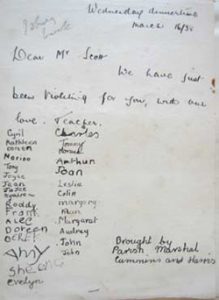
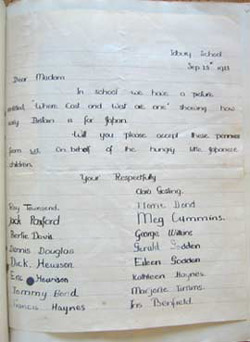
Letter of 1938 from pupils at the school with a gift of violets for John Robertson Scott. A slightly later pupil, Brian Gorton, remembers that, ‘One of the great things was primrosing, and bluebells and violets. The violets were always given to the prettiest girl.’
Letter of 1923 from pupils at the school to Elspet Robertson Scott, with a gift of pennies donated by the children for famine relief in Japan.
On 12 July 1919, Miss J. K. Jones of Charlbury was appointed Head Teacher. This is probably the single most important date in the history of the school, for Miss Jones was to have a profound and lasting impact on the village and its children. The following year Miss Soden was appointed as her deputy, and Idbury School found itself with a dynamic teaching team; Miss Soden’s place was later taken by Miss Salter. In 1923 their annual salaries were £252 for Miss Jones and £70 for Miss Soden. Mrs Duester was paid £12, presumably for cleaning or cooking, and G. Bond was paid £3, for cleaning out the earth closets. The school was one large room, with the ‘seniors’ taught downstairs and the ‘infants’ in an upstairs gallery; later a second small room was added for the infants. At one time there were as many as 100 children in the school, something almost impossible to imagine today.
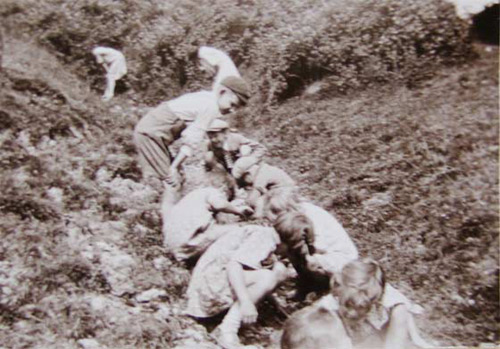
The pupils of Idbury School investigating the stream, in 1930, as part of an ongoing survey of local history and environment.
The headmistress Jessie Jones was a greatly loved and respected figure, who taught at the school from the 1920s until 1945. Generations of children benefited from her love of knowledge and of humanity. There is a memorial plaque to her in the wall of the Old School; the text reads, ‘In memory of Jessie K. Jones Head Teacher 1919-1945 this stone is placed by her grateful scholars and friends.’
In her pamphlet Idbury History, Evelyn Goshawk writes of Miss Jones:
The most noteworthy work was done at the school under the headship of Miss J. K. Jones between the years 1924 and 1931. Under her direction and inspired by her enthusiasm an extensive field-survey and study of local history was carried out over a period of years. Idbury was one of four schools engaged in an experiment in village survey-making and in a pamphlet issued by the Board of Education in 1931 an account of the work is given. An interesting page of drawings made by the children gives several kinds of agricultural implements still in use at the time, three constables’ staves and examples of prehistoric weapons from the Camp. On another page a map shows how Idbury hay was sent to Cardiff for pit-ponies, dairy produce to Moreton-in-Marsh, cattle and sheep and pigs to Kingham market and wool to Charlbury. The children explored the British Camp and the old clay-pits, traced streams to their source and studied the soil and rocks in the neighbourhood. Miss Jones encouraged them to keep all objects of interest in the school museum and then findings were recorded and deposited finally with the Oxfordshire County Library.
A copy of the Board of Education report mentioned has not yet been traced. We intend to pursue the objects and reports lodged with the County Library, and when this has been done will update this account. Two pieces of evidence are to hand: a hand-drawn map of the locality, marking all the field-names, and a photograph of the children investigating the stream that rises in Spring Hill and runs down between the fields known as The Butts and Idbury Cow Ground, to join first the Evenlode and then the Thames.

A map of Idbury made by pupils at the school in 1926 and presented to Robertson Scott. The field names were supplied by Dick Hewison (11), Eric Hewison (9), Francis Haynes (11), Dennis Douglas (11), Jack Paxford (12), George Wilkins (12), Tommy Bond (10), A. Pearse (13), and Henry Bull (8).
The second influential figure – who wrote admiringly of Miss Jones – was J. W. Robertson Scott. From the moment Robertson Scott arrived in Idbury in 1923, you can sense his influence in school affairs, though he was not elected to the management board until 1931, and indeed was in conflict with them and the vicar about the use of the school for his Village Neighbours meetings on every alternate Sunday. The fact that these meetings nevertheless went ahead indicates the strong bond of mutual respect that between Robertson Scott and Miss Jones.
It was surely Robertson Scott who encouraged the children, in a fit of shameless electioneering, to march up and down the village on election day in 1923 singing the following rhyme in support of the Liberal candidate, the cricketer C. B. Fry:
We don’t want your old Protection.
Free Trade beats it every time.
If you vote for C. B. Fry
Cheaper food you’ll surely buy.
That’s why Idbury is wearing red to-day.
This was so successful a ploy that Robertson Scott gleefully recorded that ‘The whole hamlet voted Red (Liberal) except the Minchins ! (farmer), Butt (framer) did not vote (Plymouth Brother).’
Various documents survive from the 1920s and 30s showing the close relationship between the school and the Robertson Scotts. The first is a touching letter from the schoolchildren to Elspet Robertson Scott, dated 25 September 1923. Reflecting the Scotts’ love of Japan, where they lived for some years, it reads:
Dear Madam,
In school we have a picture entitled, ‘Where East and West are one’ showing how sorry Britain is for Japan.
Will you please accept these pennies from us, on behalf of the hungry little Japanese children.
Yours respectfully,
Roy Townsend, Jack Paxford, Bertie Davis, Dennis Douglas, Dick Hewison, Eric Hewison, Tommy Bond, Francis Haynes, Clara Gosling, Florrie Bond, Meg Cummins, George Wilkins, Gerald Godden, Eileen Godden, Kathleen Haynes, Marjorie Timms, Iris Benfield, Joe Godden, Phyllis Haynes, Olive Timms, Billy Pratt, Mary Fields, Jim Bond, Violet Arthurs, Henry Bull, Cyril Davis, Bertie Fields, Cissie Fields, Doris Bond, Francis Bull, Joan Bull, Gladys Haynes, E. M. Soden, J. K. Jones.
E. M. Soden was the assistant teacher; the Sodens were the village blacksmiths. J. K. Jones was the headmistress. The 19 seniors (Roy Townsend to Phyllis Haynes) sign in ink; the 13 infants (Olive Timms to Gladys Haynes) sign in pencil. All but Bertie and Cissie Fields can sign their own names.
The programme survives of the concert put on by these children on the 7th of December, 1923. It was a variety show, in three parts. There cannot have been many tiny village schools in remote rural England at this date with the ambition or the ability to stage such an event.

The programme of the Idbury School concert, 1923, with a press report attached.
Part I
Piano solos Phyllis Haynes, Dick Hewison
Ballad Senior girls
The Red Company Senior boys
Folk song and dance All
The Glory of the Norman and Saxon Benny Townsend, Bertie Davis
Clothes Props Roy Townsend
Some Folks Do George Wilkins, Jack Paxford, Tommy Bond
Play the Game Dennis Douglas
Beautiful World Francis Haynes
Folk Song Boys and girls
Puck’s Song Eric Hewison
Part II
Welcome 7 infants
Teddy Is Ill 3 infants
My Dolly Joan Thorpe
Jack Frost Joan Bull
Fairy Land Doris Bond, D. Thorpe
Jess Gladys Haynes
Play: Little Man in the Moon (presumably the Infants)
Part III
Sketch: Wanted a Mother’s Help
Mother Phyllis Haynes
Aunt Mary Clara Gosling
5 Daughters Kathleen Haynes, Iris Benfield, Florrie Bond, Kathleen Haynes, Meg Cummins
God save the King
The End
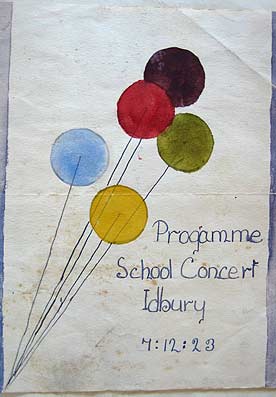
The hand-decorated front cover for the programme of the Idbury School concert, performed three times on St. Nicholas Day, 1923.
This concert was written up in glowing terms in the local paper:
The annual school concert took place in Idbury School at the Festival of S. Nicholas. It was given three times, which speaks for itself. The repeated success of the school concert year by year is due to the fine spirit of co-operation which prevails throughout the three parishes. Managers and parents alike render great assistance, not only in appreciation, but in loans of flowers, stage equipments, chairs, lamps and costumes, and the children and staff give ungrudgingly of their time and strength. This year we were handicapped by illness, but one part of the training given in the school is to meet difficulties cheerfully and overcome them. Mr. and Mrs. Robertson Scott had the very kind thought of saving the children the long two-mile walk between the afternoon and evening concert, and invited the whole school to tea at the Manor; so that they came to the second perfomance greatly refreshed and in the highest spirits. Mr. Robertson Scott presided at the concert, and at the close spoke in generous terms of the work which is being done at the school. The programme consisted of three parts, carried out by the Senior Boys, the Infants, and the Senior Girls. Every child took a more of less prominent share in entertaining, and each received its share of applause. Doris Bond, Joan Thorpe, Gladys Haynes, and Cyril Haynes showed exceptional talent for such young children. Our great objective now is an educational visit to the seaside next July, towards which the concert proceeds are given.
Cyril Haynes may be a misprint for Francis Haynes, here. The Thorpe children have evidently joined the school since September.
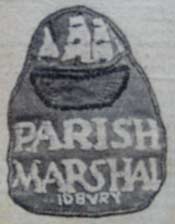
An Idbury Parish Marshal’s badge; the Parish Marshals were children appointed to keep the village tidy.
This concert programme gives a good sense of the positive energy that was kept humming through Idbury School by Miss Jones. The tender and caring side of her education, shown first by the collection of pennies by the children – themselves living in poverty – for the starving Japanese, is repeated in a letter to John Robertson Scott, marked Wednesday dinnertime, March 16/38. It reads: ‘Dear Mr Scott, We have been violeting for you, with our love.’ It is signed by the teacher and 30 children (first names only), and inscribed, ‘Brought by Parish Marshal Cummins and Harris’. The post of Parish Marshal, instituted by Robertson Scott, was a source of real pride to the children, who wore a specially-designed badge with the words Parish Marshal, Idbury and the ship of St. Nicholas.
After the Education Act of 1944 the Oxfordshire County Council proposed to modernize the school. The board of managers were unable to raise the money required, so in 1954 the school became a ‘Church of England Controlled School’, and new managers were appointed. In 1961, when Evelyn Goshawk wrote her history of Idbury, she reported the work of modernization as ‘nearly completed’. A playing field had been added to the school site, and Robertson Scott had donated an ornamental bird bath in memory of Mrs Scott; this bird bath is now in the churchyard.
Brian Gorton, who attended Idbury School in the 1940s, was the son of Florrie Bond, who can be seen as Head Girl, in her girl guide uniform, in the photo of the class of 1926 at the laying of the foundation stone for the Idbury council houses. He remembers particularly the outside toilets at the school; if a visit to these was required, the acceptable phrase was, ‘Please, Miss, can I go up round?’
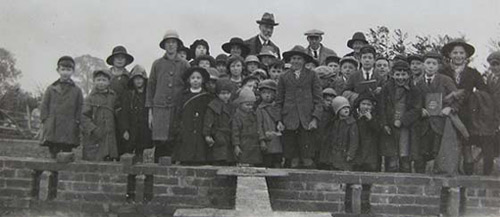
The pupils of Idbury School in 1926, at the laying of the foundation stone for the council houses, with Robertson Scott to the centre at the rear, Miss Soden and Miss Jones, and the Head Girl Florrie Bond in her Girl Guide uniform and Head Boy Jackie Paxford in his Scout uniform; both the Bonds and the Paxfords became tenants in the new houses, alongside the Fields and the Acocks.
In this very rural area, the school had a very wide catchment area. The children from Fifield were walked there and back every day by Mrs ‘Hoppy’ Davis, so-called because her husband had only one leg. The route took them over the footpath that runs through the garden of Idbury House.
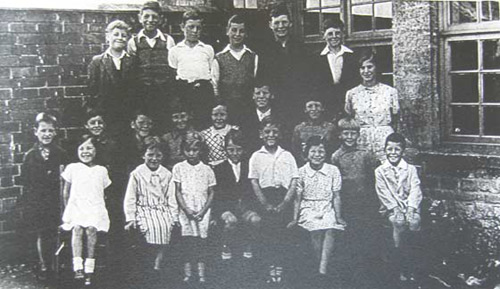
The pupils of Idbury School in the 1940s. At playtime, girls played on one side of the wall, boys on the other.
In the 1940s the local children were supplemented by a single evacuee from the East End of London, ginger-haired Lenny Watkins; he lived with Mrs Field in one of the council houses.
We hope that other ex-students of Idbury School will be able to add to these memories.
Due to falling numbers, the school was closed in 1966 and turned into a private house.
© 2008 Idbury. All rights reserved